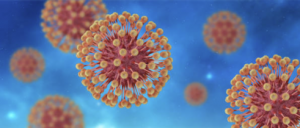Discovery of a potent antiviral agent

Tech ID
22-003
Inventors
J. McNulty
C. B. Dokuburra
L. D’Aiuto
V. Nimgaonkar
D. C. Bloom
Patent Status
US provisional patent filed
Stage of Research
Proof of concept data available
Contact
Amy Hector
Business Development Manager
Abstract
There is currently a need for better treatment options for viruses such as HSV and SARSCoV-2. For example, herpes simplex virus (HSV) is a common virus that exists in approximately 90% of the population worldwide [1]. Although clinical expression of this virus can vary, HSV carriers risk developing herpes labialis, also known as cold sores. Cold sores have an average incidence of 1.6 per 1000 patients per year and about one third of all infected patients experience relapse [2].
A novel antiviral agent with potent and selective antiviral activity to target herpes simplex virus type 1 (HSV-1) and SARSCoV-2 has been discovered [3]. This unique small molecule can be used in the treatment of DNA and RNA viruses with limited host cell cytotoxicity.
Applications
- Preparation of a topical formulation for treatment of viral skin infection.
- Potential application to other herpes pathogens such as HSV-2 and varicella, also known as chickenpox (VZV).
- Potential evolution for treatment of other viruses including zika virus (ZIKV).
Advantages
- Potent antiviral activity compared to current natural and synthetic antiviral alkaloids.
- Currently no viral resistance to the novel compound, unlike current standard HSV-1 treatments including acyclovir and valacyclovir.
References
- Wald A., Corey L (2007). Persistence in the population: epidemiology, transmission In Human Herpesviruses: Biology, Therapy, and Immunoprophylaxis. Cambridge: Cambridge University Press; Chapter 36. Available from: https://www.ncbi.nlm.nih.gov/books/NBK47447/
- Opstelten, W., Neven, A. K., & Eekhof, J. (2008). Treatment and prevention of herpes labialis. Canadian family physician, 54(12), 1683–1687.
- McNulty J., et al (2023). Truncated ring-A amaryllidaceae alkaloid modulates the host cell integrated stress response, exhibiting antiviral activity to HSV-1 and SARSCoV-2. Scientific Reports 13(1639). Available from: https://www.nature.com/articles/s41598-023-28691-0
Image obtained from: https://www.istockphoto.com/photo/micro-models-of-herpes-viruses-gm1173676633-326091423


